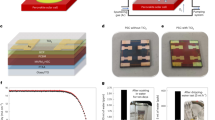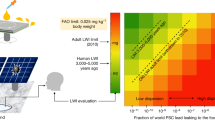Abstract
Perovskite solar cells are an emerging technology that could accelerate the energy transition to a sustainable future. However, the presence of toxic but inevitable lead poses environmental and health risks. Here we introduce on-device layers that could capture over 99.9% of leaked lead without compromising performance and operation.
This is a preview of subscription content, access via your institution
Access options
Access Nature and 54 other Nature Portfolio journals
Get Nature+, our best-value online-access subscription
$29.99 / 30 days
cancel any time
Subscribe to this journal
Receive 12 digital issues and online access to articles
$119.00 per year
only $9.92 per issue
Buy this article
- Purchase on Springer Link
- Instant access to full article PDF
Prices may be subject to local taxes which are calculated during checkout


Similar content being viewed by others
Data availability
The data that support the findings of this study are available from the corresponding authors upon reasonable request.
References
Best Research-Cell Efficiency Chart (National Renewable Energy Laboratory, 2021); https://www.nrel.gov/pv/cell-efficiency.html
Jung, E. H. et al. Efficient, stable and scalable perovskite solar cells using poly(3-hexylthiophene). Nature 567, 511–515 (2019).
Kong, L. et al. Simultaneous band-gap narrowing and carrier-lifetime prolongation of organic–inorganic trihalide perovskites. Proc. Natl Acad. Sci. USA 113, 8910–8915 (2016).
Park, S. Y. et al. Sustainable lead management in halide perovskite solar cells. Nat. Sustain. 3, 1044–1051 (2020).
Jena, A. K., Kulkarni, A. & Miyasaka, T. Halide perovskite photovoltaics: background, status, and future prospects. Chem. Rev. 119, 3036–3103 (2019).
Correa-Baena, J.-P. et al. Promises and challenges of perovskite solar cells. Science 358, 739–744 (2017).
Bae, S.-Y. et al. Hazard potential of perovskite solar cell technology for potential implementation of “safe-by-design” approach. Sci. Rep. 9, 4242 (2019).
Lyu, M., Yun, J.-H., Chen, P., Hao, M. & Wang, L. Addressing toxicity of lead: progress and applications of low-toxic metal halide perovskites and their derivatives. Adv. Energy Mater. 7, 1602512 (2017).
Hailegnaw, B., Kirmayer, S., Edri, E., Hodes, G. & Cahen, D. Rain on methylammonium lead iodide based perovskites: possible environmental effects of perovskite solar cells. J. Phys. Chem. Lett. 6, 1543–1547 (2015).
Babayigit, A. et al. Assessing the toxicity of Pb- and Sn-based perovskite solar cells in model organism Danio rerio. Sci. Rep. 6, 18721 (2016).
Babayigit, A., Ethirajan, A., Muller, M. & Conings, B. Toxicity of organometal halide perovskite solar cells. Nat. Mater. 15, 247–251 (2016).
Park, N.-G., Grätzel, M., Miyasaka, T., Zhu, K. & Emery, K. Towards stable and commercially available perovskite solar cells. Nat. Energy 1, 16152 (2016).
Jiang, Y. et al. Reduction of lead leakage from damaged lead halide perovskite solar modules using self-healing polymer-based encapsulation. Nat. Energy 4, 585–593 (2019).
Li, X. et al. On-device lead sequestration for perovskite solar cells. Nature 578, 555–558 (2020).
Chen, S. et al. Trapping lead in perovskite solar modules with abundant and low-cost cation-exchange resins. Nat. Energy 5, 1003–1011 (2020).
Chen, S. et al. Preventing lead leakage with built-in resin layers for sustainable perovskite solar cells. Nat. Sustain. 4, 636–643 (2021).
Lee, J., Kim, G.-W., Kim, M., Park, S. A. & Park, T. Nonaromatic green-solvent-processable, dopant-free, and lead-capturable hole transport polymers in perovskite solar cells with high efficiency. Adv. Energy Mater. 10, 1902662 (2020).
Mokhtar, M. Z. et al. Bioinspired scaffolds that sequester lead ions in physically damaged high efficiency perovskite solar cells. Chem. Commun. 57, 994–997 (2021).
Huckaba, A. J. et al. Lead sequestration from perovskite solar cells using a metal–organic framework polymer composite. Energy Technol. 8, 2000239 (2020).
Wu, S. et al. 2D metal–organic framework for stable perovskite solar cells with minimized lead leakage. Nat. Nanotechnol. 15, 934–940 (2020).
Huang, X. et al. Zero-wastewater capacitive deionization: selective removal of heavy metal ions in tap water assisted by phosphate ions. Environ. Sci. Nano 6, 3225–3231 (2019).
Acknowledgements
This material is based on work supported by the US Department of Energy’s Office of Energy Efficiency and Renewable Energy (EERE) under the Solar Energy Technology Office (SETO) award number DE-EE0008989. The views expressed herein do not necessarily represent the views of the US Department of Energy or the United States Government. Metal analysis was performed at the Northwestern University Quantitative Bio-element Imaging Center supported by NASA Ames Research Center grant NNA04CC36G. F.Z., J.T. and K.Z. also acknowledge the partial support of this work by the US Department of Energy under contract no. DE-AC36-08GO28308 with Alliance for Sustainable Energy, Limited Liability Company (LLC), the Manager and Operator of the National Renewable Energy Laboratory.
Author information
Authors and Affiliations
Contributions
T.X. and K.Z. designed and supervised the research. X.L., with assistance from J.W., prepared the Pb-absorbing materials and conducted the Pb leaking and capture characterization. F.Z. and J.T. fabricated and characterized the perovskite thin films and devices. All authors discussed the results and contributed to manuscript preparation.
Corresponding authors
Ethics declarations
Competing interests
T.X and K.Z. declare that an application has been made for a provisional patent (US patent application number 63/227,462) related to the subject matter of this manuscript. The remaining authors declare no competing interests.
Additional information
Peer review information Nature Sustainability thanks Hyun Suk Jun, Mohammad Khaja Nazeeruddin and the other, anonymous, reviewer(s) for their contribution to the peer review of this work.
Publisher’s note Springer Nature remains neutral with regard to jurisdictional claims in published maps and institutional affiliations.
Supplementary information
Supplementary Information
Supplementary Figs. 1–7 and Methods.
Rights and permissions
About this article
Cite this article
Li, X., Zhang, F., Wang, J. et al. On-device lead-absorbing tapes for sustainable perovskite solar cells. Nat Sustain 4, 1038–1041 (2021). https://doi.org/10.1038/s41893-021-00789-1
Received:
Accepted:
Published:
Issue Date:
DOI: https://doi.org/10.1038/s41893-021-00789-1
This article is cited by
-
Room temperature nondestructive encapsulation via self-crosslinked fluorosilicone polymer enables damp heat-stable sustainable perovskite solar cells
Nature Communications (2023)
-
Preventing lead leakage in perovskite solar cells with a sustainable titanium dioxide sponge
Nature Sustainability (2023)
-
Bioinspired “cage traps” for closed-loop lead management of perovskite solar cells under real-world contamination assessment
Nature Communications (2023)
-
Shedding light on the environmental impact of the decomposition of perovskite solar cell
Scientific Reports (2023)
-
Reducing lead toxicity of perovskite solar cells with a built-in supramolecular complex
Nature Sustainability (2023)



